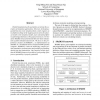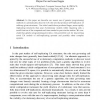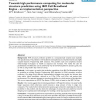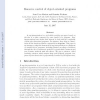884 search results - page 13 / 177 » Control structures in programs and computational complexity |
GRID
2004
Springer
14 years 28 days ago
2004
Springer
Allowing loose coupling between complex e-Science applications has many advantages, such as being able to easily incorporate new applications and to flexibly specify how the appl...
ISPAN
1999
IEEE
13 years 12 months ago
1999
IEEE
Parallel simulationhas the potentialto accelerate the execution of simulation applications. However, developing a parallel discrete-event simulation from scratch requires an in-de...
ICCS
2005
Springer
14 years 1 months ago
2005
Springer
In this paper we describe our recent use of genetic programming methods to automatically discover CA rule sets that produce self-replication of arbitrary given structures. Our init...
BMCBI
2010
13 years 7 months ago
2010
Background: RNA structure prediction problem is a computationally complex task, especially with pseudo-knots. The problem is well-studied in existing literature and predominantly ...
CORR
2007
Springer
13 years 7 months ago
2007
Springer
A sup-interpretation is a tool which provides an upper bound on the size of a value computed by some symbol of a program. Supinterpretations have shown their interest to deal with...




